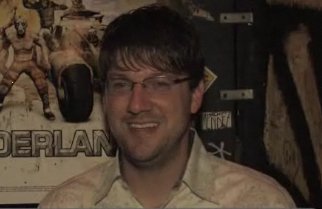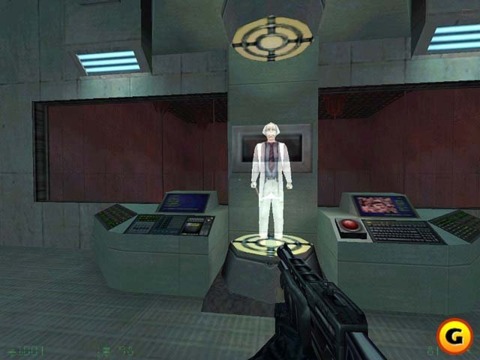Pitchford opens up on Gearbox, Borderlands a '3-million-unit game'
DICE 2010: Studio president talks success of "looter shooter," outlines the philosophy and profit-sharing that helped his company sell 25 million games worth $500 million.
LAS VEGAS--As the last day of the DICE Summit kicked off, the vast majority of attendees were still recovering from the previous evening's 13th Interactive Achievement Awards. However, at the tender hour of 10 a.m. (by Vegas standards), Red Rock Casino's Summerlin Ballroom was again near capacity for a presentation from Randy Pitchford, president of Borderlands developer Gearbox Software.

To kick things off, Pitchford gave a little personal background, discussing his stints as a Universal Studios tour guide and a professional magician while studying law in Los Angeles. Now in suburban Dallas, Pitchford dropped out of law school and relocated to pursue a job making video games. To prove his gamer cred, he showed off his Xbox Live gamerscore, which is nearly 89,000 points.
Pitchford's first gig was at 3D Realms, where he worked on the original Duke Nukem. He left in 1997, though, so his involvement in Duke Nukem Forever was "limited," and he quickly skirted the subject. He then founded Gearbox with five other colleagues and still has the first dollar the company ever made framed on his office wall. The dollar bill would become a motif in this presentation, which emphasized the challenges of balancing artistic ambition and economic realities.
FROM HALF-LIFE TO BORDERLANDS
Gearbox's first dollar came from a Sierra Entertainment check for the expansion pack Half-Life: Opposing Force, which became the nascent studio's first hit in 1999. Pitchford said that even though he often worked 18-hour days and slept under his desk, it was one of the happiest times of his career, because he was actually building games. He said that he personally created about two-thirds of the game's levels himself.
Opposing Force was a hit for Gearbox and won an Interactive Achievement Award. By the time the game shipped, the company's payroll had grown to 13, and they enjoyed further success with the expansion packs Half-Life: Blue Shift and Half-Life: Decay. (The studio also contributed to the development of PC shooter phenomenon Counter-Strike.)

With money in the bank, Pitchford took Valve Software head Gabe Newell's advice and branched out to console development. "He told me there might be something in this PlayStation 2 thing that was coming out," joked Pitchford, as Gearbox would port the original Half-Life to the console in 2001. The developer went on to work on a series of games with major publishers--the PC edition of Tony Hawk: Pro Skater 3 with Activision (2001), James Bond 007: Nightfire with Electronic Arts (2002), and the PC port of Halo: Combat Evolved with Microsoft (2003).
Having enjoyed success working on existing intellectual properties, the company decided to make an original IP, the World War II shooter Brothers in Arms. Pitchford is very proud of the series, which has been published by Ubisoft. Although 2005's Brothers in Arms: Road to Hill 30 and Brothers in Arms: Earned in Blood were successes, the long-delayed third installment, 2008's Brothers in Arms: Hell's Highway, was considered commercially disappointing.
However, the second time was the charm for Gearbox's original IP efforts, thanks to last fall's Borderlands. Pitchford took a moment to call out Wedbush analyst Michael Pachter (who was not present) for predicting that the action role-playing "looter shooter" would be effectively dead on arrival. The game had a tough launch slot last October, coming in between two top first-person shooters: Halo 3: ODST in September and Modern Warfare 2 in November. Pachter also believed that Dragon Age: Origins--which shipped just two weeks after Borderlands--would suck away RPG fans' dollars.
"You know, Michael, I knew you were wrong. Because I like a Reese's Peanut Butter Cup--it's got chocolate and peanut butter," he joked, referring to Borderlands blending of role-playing and first-person shooter elements. (In press materials, Gearbox refers to the game as a "role-playing shooter.")
When the NPD Group's 2009 US sales numbers were in, Borderlands was the top new IP in the US. "We're now looking at a 3-million-unit game," declared Pitchford. It was unclear if he meant lifetime sales to date of the game--which had sold at least 2 million units worldwide as of December--or potential lifetime sales of the game. Gearbox reps had not responded to requests for clarification as of press time.
Gearbox has also enjoyed success with the game's two expansions, the critically acclaimed Zombie Island of Dr. Ned and the coolly received Mad Moxxi's Riot. However, Pitchford promised the next expansion, the upcoming Borderlands: The Secret Armory of General Knoxx, would be bigger than the two previous expansions combined. He also said that, in a move of Spinal Tap-ian logic, the expansion will raise the level cap by 11 instead of the 10-level bump common to role-playing game expansions. ( GameSpot previewed the Secret Armory of General Knoxx this week.)
GEARBOX'S PHILOSOPHY
With Borderlands' success, Gearbox has now sold 25 million games that have grossed $500 million since its founding. With its expanded bank account, Gearbox has itself expanded. The company has gone from occupying half a floor in a Plano, Texas, office tower to three full floors, including the penthouse.
As for its future plans, the company is working on two games, code-named "Cedar" and "Oak." The two projects were on an internal schedule slide that Pitchford presented, and he was somewhat alarmed that they could be clearly read on the large screen. "Good thing we code-name all our projects after trees," he said, laughing nervously.
Pitchford then went on to explain Gearbox's corporate philosophy. First and foremost, the company is about entertaining people--both a general audience and themselves. "I want to make sure that everything we do at our studio are things we want to do," he explained.
As a studio, Gearbox has three goals:
1. Be creative: "Be inventors and solve problems," as Pitchford put it.
2. Happiness: A harmonious workplace is key, so Gearbox applies the "3D policy" when hiring--"No drama, no dicks, no douche bags."
3. Make money: Game development is a business, so profit is key. Pitchford said the biggest challenge is that often creativity and happiness cost money. So it's important to always think about money, since that can help with the other two goals.
According to Pitchford, this studio's core mission is grappling with what he calls the "artist's dilemma." He says that as artists, the creative minds at Gearbox can visualize perfection very clearly, but nothing they--or any human--will ever do can be perfect.
He asked the audience, "So the question is, when do you stop [going for perfection]? How imperfect is 'good enough?'" He held up the example of the Mona Lisa, which is considered one of the greatest artworks of Western civilization. "It isn't perfect."
As a former programmer, Pitchford uses math to look at the world, and believes "Perfection is an asymptote." An asymptote is a line that forms a curve that approaches but never touches zero, instead going on infinitely.
After showing the asymptote curve in abstract, he shows the asymptote curve as Gearbox sees it: a curve between game quality vs. money. The curve won't ever touch perfection, but it will continue to cost the developer money as long as they can work on it.
"So where is the sweet spot? When do we stop [working on a game]? That's the dilemma we all face," explained Pitchford. He then went on to show how time skews the graph and accelerates costs. This problem brings up an obvious--and infamous--example.
"Now, this is where I could talk about Duke Nukem [Forever], but I'm not going to," Pitchford said. "I owe George Broussard…my career, so I am not going to say anything bad. I just want to make that clear to all the journalists out there."
SHARING THE LOOT
How does Gearbox determine where the "sweet spot" is? Pitchford says an aggressive profit-sharing scheme instills a sense of ownership in all Gearbox's employees. Through a combination of profit sharing, milestone incentive payments, stock options, and discretionary merit pay, Gearbox returns 40 percent of its profit to its employees, retaining the rest for its future development.
When asked by a former colleague why he gives away 40 percent of his profit, Pitchford said, "It's simple. I'm greedy, and having this system makes everyone work harder and allows other people to want to make good decisions…It makes every single person in the organization want to create a great product with maximum profit…and allows them to be team players. It allows us to say 'Oh yeah, this is the sweet spot,' and stop."
Got a news tip or want to contact us directly? Email news@gamespot.com
Join the conversation